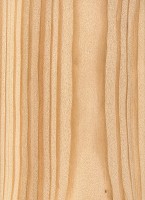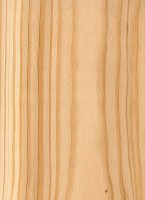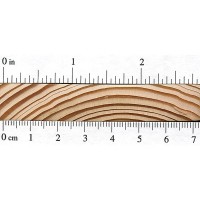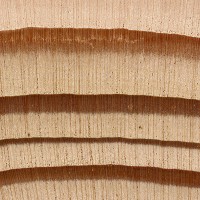 |
Common Name(s): Western Larch Scientific Name: Larix occidentalis Distribution: Northwestern North America Tree Size: 100-180 ft (30-55 m) tall, 3-5 ft (1-1.5 m) trunk diameter Average Dried Weight: 36 lbs/ft3 (575 kg/m3) Specific Gravity (Basic, 12% MC): .48, .58 Janka Hardness: 830 lbf (3,690 N) Modulus of Rupture: 13,000 lbf/in2 (89.7 MPa) Elastic Modulus: 1,870,000 lbf/in2 (12.90 GPa) Crushing Strength: 7,620 lbf/in2 (52.6 MPa) Shrinkage: Radial: 4.5%, Tangential: 9.1%, Volumetric: 14.0%, T/R Ratio: 2.0 |
Color/Appearance: Heartwood ranges from yellow to a reddish brown. Narrow sapwood is yellowish white and is clearly demarcated from the heartwood. Flatsawn sections can exhibit a lot of character and interesting patterns in the growth rings. Knots are common but are usually small.
Grain/Texture: Grain is generally straight. Texture is medium to coarse with a greasy or oily feel.
Endgrain: Small resin canals, infrequent and variable in distribution; solitary or in tangential groups of several; earlywood to latewood transition abrupt, color contrast high; tracheid diameter medium-large. (Growth rings are generally narrower in Western Larch than in Tamarack.)
Rot Resistance: Moderately durable regarding decay resistance.
Workability: Most hand and machine operations produce good results. However, Western Larch is high in silica content and will blunt cutting edges. Also, because of the disparity between the soft earlywood and the hard latewood, sanding can create dips and uneven surfaces.
Odor: No characteristic odor.
Allergies/Toxicity: Although severe reactions are quite uncommon, wood species in the Larix genus have been reported to cause skin irritation, as well as hives and skin lesions. See the articles Wood Allergies and Toxicity and Wood Dust Safety for more information.
Pricing/Availability: Western Larch trees grow much larger than the closely related Tamarack, and the species is much more commercially important as well. Western Larch is frequently mixed with Douglas Fir and sold as construction lumber and stamped with the initials “DF-L.” Prices should be moderate.
Sustainability: This wood species is not listed in the CITES Appendices, and is reported by the IUCN as being a species of least concern.
Common Uses: Veneer, plywood, paper (pulpwood), particleboard, glue-laminate beams, construction lumber, and flooring.
Comments: Western Larch is the most commercially important Larix species in North America. It’s also one of the hardest softwoods in the United States, with a Janka hardness of 830 lbf—about as hard as American Elm.
None available.








Venice foundation was built partially by larch.
Western Larch is found in occasional pockets throughout central Oregon. Some of these pockets produce Larch that is much harder, denser and resistant to rot than what is typical of the species. These special Larch grow over 100′ tall with a diameter of 10″ at chest level. It is common to find Larch lying on the forest floor, partially and completely submerged in soil from other species of tree having fallen over top and decomposed for many decades (centuries?). These logs pull from the earth with a thin layer of surface rot that abruptly transitions to hard, orange wood. Rot… Read more »
Agreed. When I did block layout in the Kootenays, we would always look for Larch stumps to break wood off for a lunch fire. There would be regenerating stands where the pine and fir stumps would be soil, but the larch would be hard and dry and dense – ideal for fuel. As a wood I feel its underrated, as heartwood often has a orange-red colouration which gives a real character to a plank.
Here is one of my furniture projects using western larch donated by Kalesnikoff lumber from Nelson BC. This chair was crafted by a team of designers (myself included) from Emily Carr University which was showcased and sponsored by a local furniture store near downtown Vancouver. The larch is beautiful to look at and is reminiscent of Douglas Fir. It’s quite a stable material to work with and easy to machine.
Here is one of my furniture projects using western larch donated by Kalesnikoff lumber from Nelson BC. This chair was crafted by a team of designers (myself included) from Emily Carr University which was showcased and sponsored by a local furniture store near downtown Vancouver. The larch is beautiful to look at and is reminiscent of Douglas Fir. It’s quite a stable material to work with and easy to machine.